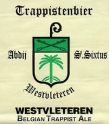| |
The Famous Five
by Willard Clarke, 08/08
To accompany my feature article on the Trappist beers of Achel, I thought this was a good moment to reintroduce the 'Famous Five' beers brewed by Trappist brothers.
Chimay
Best-known and, with Westmalle, biggest of the Trappist breweries. Chimay produces three beers named after their bottle caps: Red (7%), White (8%) and Blue (9%). Confusingly, bigger corked and cradled bottles are labelled
Grand Cru, Cinq Cents and Grande Reserve respectively. Red is brewed with Pils and caramalt and hopped with American and German varieties.
It is copper-coloured with blackcurrant fruit on the aroma and palate, along with touches of nutmeg and spicy hops. The finish is vinous, spicy with a good underpinning of hop bitterness.
White is brewed with Pils
malt and a touch of caramalt and hopped with American Galena and German Hallertauer. It has a big citrus fruit aroma and palate, a hint spice and a big dry finish with tart fruit and bitter hops. Blue is made with Pils
malt and the same blend of hops and the addition of candy sugar. It has a deep copper colour, with an enormous vinous fruitiness on the aroma and palate, a spicy note and a rich and fruity finish with a good hop base.
|
|
|
Orval
The abbey is in beautiful countryside in the Ardennes. It is unique among the Trappist breweries for producing just one beer, 6%. Its gold/bronze colour comes from four or five different malt varieties with a touch of English crystal malt. Hops are English, German and Slovenian. The beer enjoys three fermentations, one with the addition of a "wild" Brettanomyces strain used in the production of lambic and gueuze beers. Incredibly complex beer with peppery hops, tart fruit, herbs and a touch of lactic sourness.
|
|

|
Rochefort
Another monastery in the Ardennes but more remote than Orval. Rochefort proves there is no such thing as a Trappist style as the beers - 7.5%, 9.2% and 11.3% -- are notably soft and malty. The former head brewer, Father Antoine, said they adhered to their original use as "liquid bread" during fasting. The copper-red beers are brewed with Pils and Munich malts with candy sugar and hopped with German Hallertauer and Styrian Goldings. More sugar is added to encourage a good bottle fermentation. They are fruity with powerful hints of chocolate, ripe grain and gentle, spicy hops.
|
|

|
Westmalle
The abbey is in bleak, flat countryside close to Antwerp. It produces two beers, Dubbel (7%) and Tripel (9.5%): the terms are now widely used by other brewers to denote beers of that strength. Dubbel is brewed with Pils malt, dark malt and candy sugar and hopped with Tettnanger, Saaz and Styrian Goldings. It is russet coloured, with a chocolaty, fruity and spicy aroma and palate. The finish is complex with hints of guava and other tropical fruits. In sharp contrast, Tripel is brewed with Pils malt only and the same blend of hops. It has a Saaz-inspired aroma of orange fruit with a tangy, fruity palate and big spicy notes, and a long finish with resiny hops and a touch of herbs.
|
|

|
Westvleteren
Smallest and most reclusive of the Trappist monasteries, close to Ypres and the hop fields of Poperinge. Almost impossible to get in to but the beers can be sampled in the Cafe Vrede across the road. It's output is only slightly bigger than Achel's. The three beers are Blond, Extra and Abt (5.8%, 8% and 11%). Only pale malt is used: the beers have different colours as a result of the sugars used. The hops are Northern Brewer and the yeast culture came from Westmalle. Blond has a herbal, hoppy aroma, a firm malty body balanced by tart hops, and light, fruity, hoppy finish.
|
|

|
Extra has a deep russet colour with an aroma and palate of plummy fruit, ripe malt, fruit and hops, and a complex finish of rich malt, tart hops and bitter fruit. Finally Abt (Abbot) is a rich, dark brown beer with a big attack of vinous fruit, toffee and roasted grain on the nose, chewy malt, dark fruit and hops in the mouth, and a toasted grain and bitter hops finish.
*All bottle-fermented Trappist beers will improve with a year in the cellar. They should be served cool but not chilled. Stronger and darker beers can be served at room temperature.
|
|





